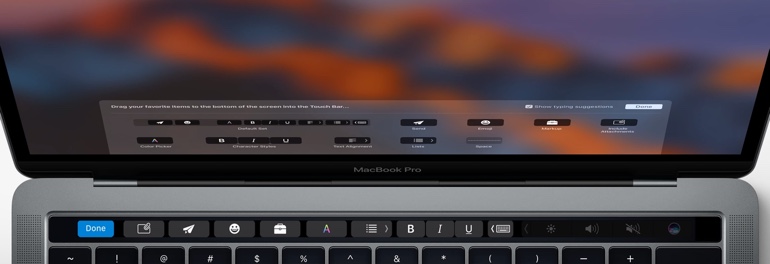Surface Studio and MacBook Pro forge diverging paths to PC productivity


The MacBook Pro Touch Bar offers touch flexibility without a making the main display a touch screen.
Even the most sensor-packed conventional PC designs have lacked the interaction experience of a cradled computer. As Steve Jobs marveled at the introduction of the iPad, "Right there, holding the Internet in your hands, it's an incredible experience."
This week's major product introductions by Microsoft and Apple, though, embrace that experience intimacy in ways that extend well beyond previous desktops and laptops. The developers of the two dominant computer operating systems have taken divergent paths toward achieving this, but have had some surprisingly similar results.
In writing about Microsoft's Surface Studio, I noted that previous tabletop PCs had reclined into a pose similar to one of Microsoft's new all-in-one. But these computers lacked a stylus as responsive as Microsoft's Surface Pen. And they certainly lacked the ability of the Surface Dial to act as an on-screen control.
Microsoft demonstrated how the two input devices could be used in tandem to finely control drawing of a rainbow-like brush stroke on Surface Studio, the only device that can use the Surface Dial on-screen in that way. (Other Windows devices can use it as a standard Bluetooth controller.) The company portrayed working in this manner as akin to working on a canvas with little coming between creator and creation.
More on Surface: Microsoft aims high with new Surface hardware | Surface Studio shows up the iMac but won't unseat it | Surface Dial, hands-on
In contrast, the bold new interface addition to Apple's revamped MacBook Pro favors getting controls off the screen. Keeping with the company's stand that touch screens represent too far of a stretch for regular interaction, the Touch Bar presents a narrow yet multitouch-enabled strip of crisp OLED color that can change appearance and functionality to enhance interaction with any application that supports it.
Apple's slimmest and lightest MacBook Pros ever reflect that great keyboards are still critical for a laptop experience. However, in taking the place of the little-used function keys, the Touch Bar acknowledges Apple's argument -- first expressed in the iPhone -- that space used for keyboards should be open to developers.
Indeed, it keeps all input devices, including the keyboard and gigantic new trackpad, stacked together on the base of the laptop. Apple's MacBook Pro introduction also included a segment where two input devices -- the trackpad and Touch Bar -- were used together to flip through effects in Photoshop, with the presenter noting that the experience was like using a musical instrument.
More on MacBook: Apple revamps MacBook Pro with Touch Bar | Hands-on: New MacBook Pro is a looker | MacBook Pro - Tech specs | CNET: Does the Mac still matter?
Which approach is better?
First, it should be noted that there's nothing mutually exclusive about Apple's and Microsoft's implementations in theory. The Microsoft approach evokes more direct digital manipulation. Apple would have a hard time arguing against that as it extols a similar way of working with its iPad Pro and Apple Pencil. In contrast, the Touch Bar experience seems to take palette or ribbon-like controls and reduce the impact of their on-screen clutter for a potentially cleaner work surface.
While the Surface Studio's specs make it a strong option for many applications, its combination of reclining screen and optional Surface Dial is more specifically aimed at those creating output such as artwork or video or possibly a task such as scoring music. In contrast, the Touch Bar has near universal benefit; indeed, it houses the Touch ID sensor that can be used every time the notebook is turned on.
One thing's for sure. Early adopters will pay a premium for getting closer to PC user experience nirvana. The Touch Bar-equipped 13" MacBook Pro starts at $1,799, $300 more than a slower model with fewer Thunderbolt ports that lacks the interactive strip. The Surface Studio starts at $2,999 with the Surface Dial adding another $99. Drawing, twisting and swiping can all be effective controls for increasing PC profit margins.